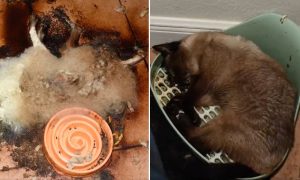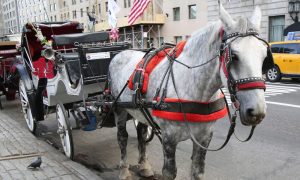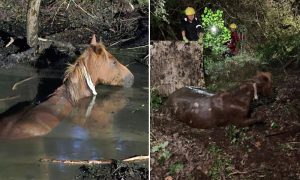Patrick Hardison, a Mississippi firefighter, was severely burned in 2001 while on duty. The incident left his face severely disfigured — but one year after the most extensive face transplant ever performed, Patrick’s life has turned for the better.

Patrick Hardison on holidays with his family at Disney World – Photo courtesy NYU Langone Medical Center
“The surgery has truly given me back my life,” Hardison explained in a press release. “I go about my day just like everyone else. It’s allowed me to do things with my family that I had not been able to do. I can’t tell you what a sense of freedom it is to even drive my kids to school. We recently went on a family vacation to Disney World, and I swam in the pool with them – something I hadn’t done in 15 years.”
The transplants required the effort of more than 100 medical specialists, led by Eduardo D. Rodriguez, chair of the Hansjörg Wyss Department of Plastic Surgery at NYU Langone.
Rodriguez described the recovery as “exceeding all expectations.” The most important achievement, the lack of rejection episodes, is the result of careful planning.
“We believe this has much to do with the methodical approach we took in the matching process to ensure that Hardison’s donor provided the most favorable match,” Rodriguez said. “Doing so also has allowed us to reduce the levels of certain medications that Pat takes to prevent rejection.”
And for Hardison, this has meant a sensible improvement in the quality of his life. As he recounts, after living for 14 years with a heavily burned face, “There are no more stares, no more frightened children running away from me. I’m pretty much just a normal guy.”
Hardison is now planning to visit the family of his donor, David Rodebaugh, to personally thank them. He also wants to help promote face transplants, especially among his fellow firefighters.
“I am especially proud to share my story with other injured firefighters and first responders, as well as injured members of the Armed Services,” said Hardison. “If sharing my story helps just one person explore the possibility of a face transplant, then it’s been worth it.”
Face transplants are becoming a more viable medical solution to disfigurement, despite their complexity. They are generally paid for, at least partially, by researching funding. The Department of Defense is working with. Rodriguez and LiveonNY, the organ donors’ organization of New York, to increase organ donation.
“With many successful transplants, there is a donor or donor family that makes these altruistic gifts possible,” said Helen Irving, president and CEO of LiveOnNY, in a press conference
Rodriguez is optimistic for the future of this surgery, “[with the work done] pushing the boundaries of medicine and surgery and opening up new avenues to restore the lives of people like Patrick”.






